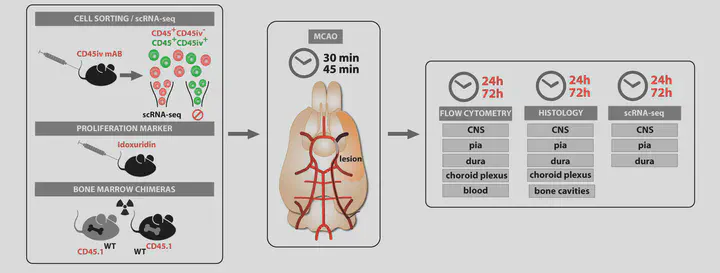Stroke induces disease-specific myeloid cells in the brain parenchyma and pia
Feb 1, 2022·,,,,,,,,,,,,,,,,,,·
0 min read
Carolin Beuker
David Schafflick
Jan-Kolja Strecker
Michael Heming
Xiaolin Li
Jolien Wolbert
Antje Schmidt-Pogoda
Christian Thomas
Tanja Kuhlmann
Irene Aranda-Pardos
Noelia A-Gonzalez
Praveen Ashok Kumar
Yves Werner
Ertugrul Kilic
Dirk M. Hermann
Heinz Wiendl
Ralf Stumm
Gerd Meyer Zu Hörste
Jens Minnerup

Abstract
Inflammation triggers secondary brain damage after stroke. The meninges and other CNS border compartments serve as invasion sites for leukocyte influx into the brain thus promoting tissue damage after stroke. However, the post-ischemic immune response of border compartments compared to brain parenchyma remains poorly characterized. Here, we deeply characterize tissue-resident leukocytes in meninges and brain parenchyma and discover that leukocytes respond differently to stroke depending on their site of residence. We thereby discover a unique phenotype of myeloid cells exclusive to the brain after stroke. These stroke-associated myeloid cells partially resemble neurodegenerative disease-associated microglia. They are mainly of resident microglial origin, partially conserved in humans and exhibit a lipid-phagocytosing phenotype. Blocking markers specific for these cells partially ameliorates stroke outcome thus providing a potential therapeutic target. The injury-response of myeloid cells in the CNS is thus compartmentalized, adjusted to the type of injury and may represent a therapeutic target.
Type
Publication
Nature Communications